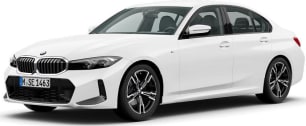What you’re buying here is not a car in a different size or luxury category compared with its S3 and A3 stablemates, but a car with a much broader performance envelope. So it’s no surprise to learn that a lot of the extra money goes into that type of hardware.
So rather than the class-standard four-cylinder engine, the RS3 gets a five-cylinder engine measuring 2.5 litres and enough performance to challenge many a supercar of just a handful of years ago. That philosophy also requires bigger brakes, firmer suspension and a more complex, track-oriented version of the electronic rear differential that can turn the car into a drifter or a race-track hero. Wheels and tyres are competition-spec, too.
In turn, those changes have forced other alterations such as the wider fenders and more intricate body kit, the former to physically fit the tyres, the latter to control air-flow for high-speed stability and for thermal management.
Other RS3 additions to what was an already well-equipped car in the S3, include lots of Audi’s trademark honeycomb styling panels around the car, RS3 puddle lighting, LED headlights and daytime running lights, carbon and aluminium interior inlays, RS sports seats with four-way lumbar support and a massage function.
There are two USB ports, wireless phone charging, another pair of USB ports in the rear, Bang and Olufsen stereo, head-up display, tinted glass, heated, folding exterior mirrors and Nappa leather throughout the interior. There’s also Android Auto, a wireless version of Apple CarPlay and digital radio.
The RS3 uses Audi’s celebrated virtual cockpit display with a choice of display layouts for the driver as well as a 10.1-inch touchscreen to control all the connectivity and infotainment settings. It uses the latest version of Audi’s MMI interface.
Like the other A3-based Audis, there’s a price premium for the sedan body over the hatchback, making the five-door RS3 a $91,391 purchase against the sedan at $93,891. Compared with the S3 CarsGuide tested earlier this year, that represents a pretty big jump from that car’s $70,700 (hatch) and $73,200 (sedan). That said, there’s a fair bit more going on in the RS3 in every department, but you get the sense that this comparison will be one nearly every potential buyer will make.
Like most Audis, there’s a range of optional packages, starting in the RS3’s case with the Carbon Package which brings carbon-matte inlays to the interior, side skirts, exterior mirrors and a carbon roof spoiler for the Sportback and a carbon roof-lip spoiler for the sedan. That costs $7400 on the hatch and $6300 on the sedan.
The Matte Aluminium Package is next with a few trim pieces finished in an aluminium material for $2000 extra and there’s also a panoramic sunroof on offer for $2600.
The RS Design Package gets you an Alcantara-covered steering wheel, seat belts in green or red as well as coloured elements to the seat shoulders, floor mats and the air-vent highlights. Yours for $2150.
The most serious option is the RS Dynamic Package which brings carbon-ceramic brakes with a choice of caliper colour as well as an electronic reflash to bring the top speed of the RS3 to 290km/h from its standard (limited) 250km/h. That adds another $13,000 to the price.
One thing that’s nice to see is that Audi has made even the pearl and metallic colours a no-cost option on the RS3. Other manufacturers should take note.


















